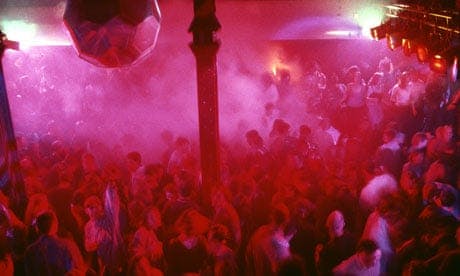
Image : Peter J Walsh
Written By Jon Savage
On 27 January 1984, music show The Tube visited the Haçienda. As part of the evening, Madonna was filmed lip-syncing Holiday with a couple of dancers. The clip still exists and you can see her rocking the definitive early-to-mid-80s B-boy look: big hair tied up at the back, layered sports wear and synchronised dance moves.
Although displaying considerable hauteur, Madonna wasn’t a big star then: her first UK hit, Holiday, was just moving up the charts when the clip was filmed. Yet it made sense to showcase this product of the New York electro scene in one of the UK’s most unique and innovative clubs. For the Haçienda was conceived specifically, as New Order manager Rob Gretton later said, as a “New York-type club”.

Launched in May 1982, the Haçienda was beautifully designed by Ben Kelly, with themed bars and branded colours and typeface. This former yacht warehouse was conceived as a meeting place for Manchester’s scattered post-punk tribes: as Rob Gretton later remembered, there was “nowhere else to go”. There was also the idea to give something back to the city that had spawned and nurtured Joy Division and New Order.
The Haçienda wasn’t the disaster that it has been portrayed. The club had strong musical roots in the then current avant garde/black electro crossover. As Tony Wilson later said: “It was very much conceived as a space. We had just been to America, New Order and ACR’s first tours, clubs like Danceteria and Hurrah, and these clubs were discos and venues; venues and discotheques. Groovy spaces.”
This was the period when New York DJs regularly worked with British post-punk groups. François Kervokian, for instance, who played at the Paradise Garage, did a brilliant remix of Yazoo’s Situation while Arthur Baker and Jellybean Benitez, both of whom played at the Warehouse and had done mixes of Afrika Bambaataa’s Planet Rock, reworked New Order’s follow-up to Blue Monday, Confusion. Benitez was also the producer of Madonna’s Holiday.
During its first two years, the Haçienda showcased gigs by artists as diverse as Orange Juice, J Walter Negro, the Psychedelic Furs, the Gun Club, the Smiths, Grandmaster Flash and Curtis Mayfield. In the DJ box, Mike Pickering and Hewan Clarke played the latest electro and rap 12-inches. The problem was not the club’s musical policy, but the fact that it was open every night – a guaranteed way of losing money.
The club started to break even in 1986 with the success of Mike Pickering and Martin Prendergast’s Nude night – one of the UK’s first adopters of the emergent Chicago house sound. This was soon amplified by another popular night, Zumbar, Paul Cons’s mix of fashion show and cabaret entertainment, with a disco and house soundtrack.
Things exploded in July 1988 with the creation of Hot – conceived by Paul Cons and Mike Pickering as a “New York-styled balearic” night. Coinciding with the introduction of ecstasy as a popular youth cult drug, and the rise of acid house, this sparked a sequence of delirious nights, later known as the second Summer of Love. As Mike Pickering later said: “It was the best scene I’ve ever been involved in, there were people from all walks of life, all getting on and it was so creative when it first started.”
The delirium continued through 1989, but in July there was a severe reality check when 16-year-old Clare Leighton collapsed at the club and later died as a result of taking ecstasy. Combined with the Madchester hype – concentrated on a number of indie bands with dance inflections – the Haçienda’s days were numbered, as the club came under scrutiny from police, licensing authorities and gangsters alike.
The next two years saw the club constantly under threat from the police, from the licensing authorities and the increasingly violent activities of the gangs. The Haçienda closed for the first time in January 1991, reopening four months later. However even under this duress, the club hosted another successful and innovative night with the introduction of Paul Cons and Lucy Scher’s Flesh – “an outrageous queer event” that had huge influence on gay clubbing in the UK. (It also had the side effect of temporarily putting off most of the gangsters.)
The Haçienda eventually closed in June 1997, having failed to stem the gang violence. After lying empty for a few years, it was demolished in 2002 – the fixtures and the fittings having already been auctioned off for charity. The site had been redeveloped and is now a multistorey block called the Hacienda Apartments.
Although the physical building has gone, the Haçienda remains legendary not only for the breadth and depth of its musical policy and its status as a youth culture catalyst, but also for its pioneering vision of the club as a brand. After the Haçienda came Cream, Ministry of Sound, and the deluge.
Read the original Guardian article here.

